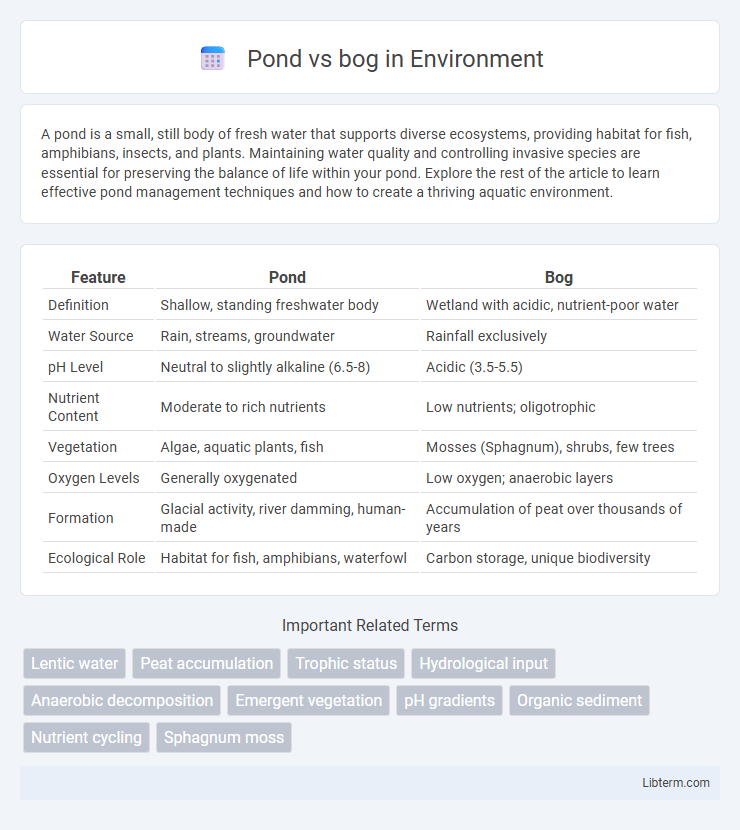A pond is a small, still body of fresh water that supports diverse ecosystems, providing habitat for fish, amphibians, insects, and plants. Maintaining water quality and controlling invasive species are essential for preserving the balance of life within your pond. Explore the rest of the article to learn effective pond management techniques and how to create a thriving aquatic environment.
Table of Comparison
| Feature | Pond | Bog |
|---|---|---|
| Definition | Shallow, standing freshwater body | Wetland with acidic, nutrient-poor water |
| Water Source | Rain, streams, groundwater | Rainfall exclusively |
| pH Level | Neutral to slightly alkaline (6.5-8) | Acidic (3.5-5.5) |
| Nutrient Content | Moderate to rich nutrients | Low nutrients; oligotrophic |
| Vegetation | Algae, aquatic plants, fish | Mosses (Sphagnum), shrubs, few trees |
| Oxygen Levels | Generally oxygenated | Low oxygen; anaerobic layers |
| Formation | Glacial activity, river damming, human-made | Accumulation of peat over thousands of years |
| Ecological Role | Habitat for fish, amphibians, waterfowl | Carbon storage, unique biodiversity |
Introduction: Pond vs Bog
A pond is a small, still body of freshwater typically characterized by shallow depths and abundant plant life, supporting a diverse range of aquatic organisms. A bog is a type of wetland ecosystem dominated by sphagnum moss, acidic water, and peat accumulation, creating unique conditions that limit biodiversity. Understanding the distinctions between ponds and bogs is essential for ecological conservation and wetland management.
Defining Ponds and Bogs
Ponds are small, shallow bodies of freshwater characterized by still or slow-moving water, often supporting diverse aquatic plants and wildlife. Bogs are a type of wetland with waterlogged, acidic, and nutrient-poor conditions, dominated by sphagnum moss and peat accumulation. The primary distinction lies in their ecological composition and hydrology, with ponds being open water habitats and bogs representing unique peat-forming ecosystems.
Key Environmental Differences
Ponds are shallow freshwater bodies with open water areas that support a variety of aquatic plants and animals, often characterized by mineral-rich water and good oxygen levels. Bogs are wetland ecosystems with acidic, nutrient-poor water, dominated by sphagnum moss and peat accumulation, creating an environment that slows decomposition and supports specialized plant species. The primary environmental difference lies in water chemistry and nutrient availability, impacting biodiversity and ecological functions in each habitat.
Water Sources and Hydrology
Ponds typically receive water from surface runoff, groundwater inflows, and precipitation, maintaining relatively stable water levels with clear, open water. Bogs are primarily fed by precipitation, resulting in nutrient-poor, acidic, and saturated conditions with slow hydrological turnover. The hydrology of ponds supports diverse aquatic life, while bogs exhibit waterlogged, anaerobic environments that limit decomposition and encourage peat accumulation.
Types of Flora and Fauna
Ponds typically support diverse aquatic plants such as water lilies, cattails, and algae, attracting fauna like frogs, turtles, and various fish species. Bogs feature specialized flora adapted to acidic, nutrient-poor conditions, including sphagnum moss, carnivorous plants like pitcher plants, and heather, hosting fauna such as dragonflies, small amphibians, and certain bird species adapted to wetland habitats. The contrasting water chemistry in ponds and bogs results in distinct ecosystems with unique biological communities.
Soil and Substrate Composition
Ponds typically have mineral-rich substrates composed of sand, silt, or clay, providing a relatively stable and nutrient-balanced environment that supports diverse aquatic life. Bogs are characterized by acidic, nutrient-poor, and waterlogged peat soils formed from accumulated partially decomposed plant material, primarily sphagnum moss. The distinct soil chemistry and organic content in bogs create unique conditions favoring specialized vegetation and slow decomposition rates compared to the more mineral-based and dynamic substrates found in ponds.
Ecological Benefits and Roles
Ponds provide critical habitats for diverse aquatic species, supporting amphibians, insects, and plants that contribute to water filtration and nutrient cycling. Bogs act as carbon sinks, storing vast amounts of carbon in their peat layers and helping regulate atmospheric greenhouse gases. Both ecosystems play essential roles in maintaining biodiversity and enhancing water quality within their respective landscapes.
Human Uses and Interactions
Ponds provide essential habitats for recreational activities such as fishing, swimming, and boating, while also supporting agricultural irrigation and aquaculture. Bogs, rich in peat, are harvested for fuel and horticultural products, and their unique ecosystems offer scientific research opportunities into carbon sequestration and climate regulation. Human interaction with bogs often emphasizes conservation due to their role in biodiversity and water purification, contrasting with the more direct resource use commonly associated with ponds.
Conservation Challenges
Ponds face conservation challenges such as pollution, eutrophication, and habitat fragmentation, which threaten aquatic biodiversity and water quality. Bogs struggle with issues like peat extraction, drainage, and climate change, leading to carbon release and loss of unique flora and fauna. Effective conservation strategies must address these distinct threats by promoting habitat protection, restoration, and sustainable management practices.
Choosing Between a Pond and a Bog
Choosing between a pond and a bog depends on your desired ecosystem and maintenance level; ponds are open water bodies supporting fish and aquatic plants, while bogs are nutrient-poor wetlands dominated by mosses and acid-tolerant vegetation. Ponds require regular water quality management and aeration, whereas bogs thrive on minimal intervention with naturally acidic, stagnant water conditions. Consider your local climate, soil acidity, and long-term ecological goals to determine whether a pond's biodiversity or a bog's unique habitat best suits your landscape.
Pond Infographic

 libterm.com
libterm.com